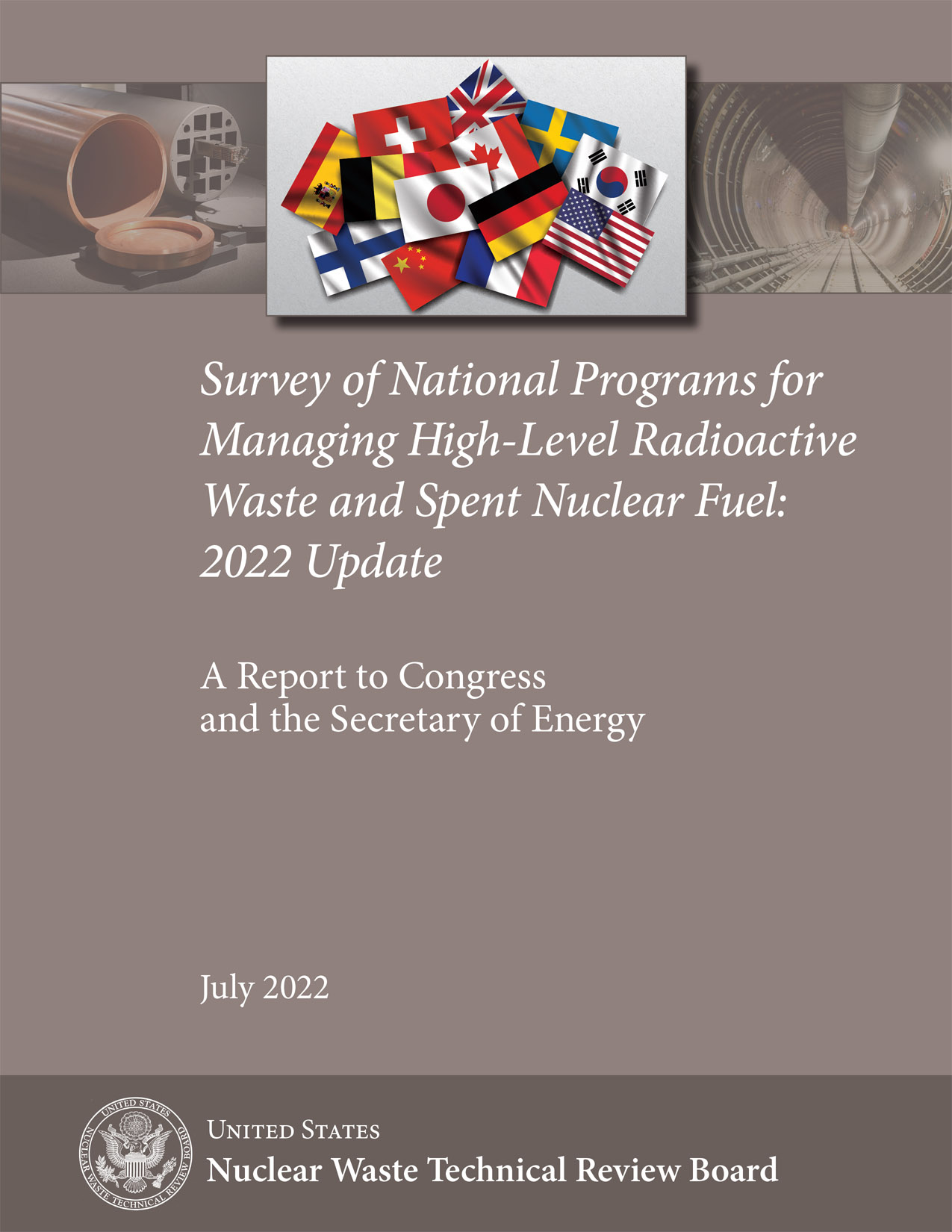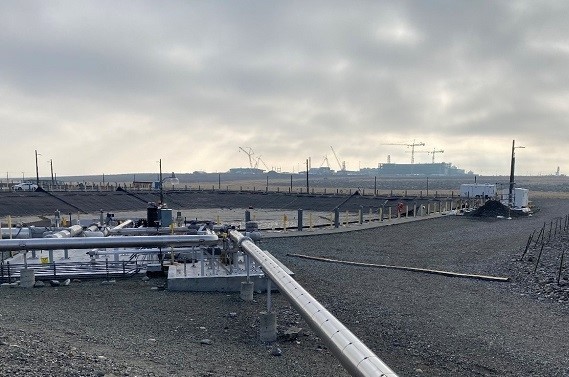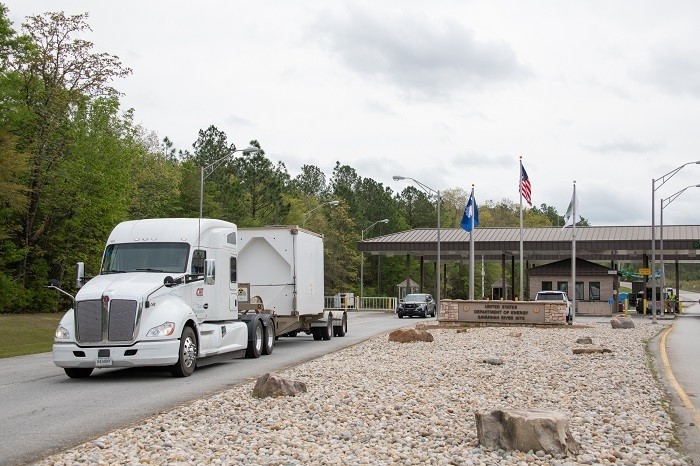Pictured during a tour of the EBR-II site are, from left, Robert Boston, DOE-ID manager; Rep. Mike Simpson (R., Idaho); Secretary Granholm; Director Wagner; and Marianne Walck, INL deputy laboratory director for science and technology. (Photo: INL)
Energy Secretary Jennifer Granholm visited Idaho National Laboratory on August 3 to meet with INL staff, including director John Wagner, as she toured key research facilities on INL’s 890-square-mile site and the lab’s campus in Idaho Falls.
A worker replaces a manipulator arm at the Savannah River’s SWPF. (Photo: DOE)
Savannah River Mission Completion (SRMC), the radioactive liquid waste contractor at the Department of Energy’s Savannah River Site, is optimizing some equipment maintenance at the Salt Waste Processing Facility (SWPF). The facility traditionally uses centrifugal contactors in the solvent extraction process, and its laboratory uses manipulators to handle process samples and equipment within its radioactive cell. The equipment requires periodic maintenance and rebuilding.
Native bees swarm near a hive at the former K Reactor Area on the Hanford Site. Bees swarm and begin looking for a new place to nest when a colony becomes overcrowded. (Photo: DOE)
The area near the Hanford Site’s former K reactors is buzzing with activity as several of the Department of Energy’s environmental cleanup projects continue near the Columbia River in Washington state.
That’s not the only thing that’s buzzing, however. While preparing some old equipment for removal earlier this spring, workers with Central Plateau Cleanup Company (CPCCo), a contractor of the DOE Office of Environmental Management Richland Operations Office, discovered a large colony of native bees.
Savannah River National Laboratory (Photo: DOE)
When the Department of Energy announced Innovation Network for Fusion Energy (INFUSE) awards earlier this month, Savannah River National Laboratory was named a recipient of two of the 18 awards. SRNL released a statement on July 19 explaining how a national lab with a long history of supporting environmental management and national security missions can lend a hand in the development of future commercial fusion power.
A screenshot taken from a INL video demonstrating MAGNET and its digital twin. (Source: INL)
Researchers at Idaho National Laboratory (INL) recently performed their first digital twin test of the Microreactor Agile Non-nuclear Experimental Testbed (MAGNET) and captured the demonstration in a video posted July 14. The digital twin—a virtual representation of a microreactor—was built using advancements in remote monitoring, autonomous control, and predictive capabilities that could help lower operating costs of microreactor technologies and enhance their safety.
The first plasmas created in FuZE-Q, shown here during assembly, represent a key step towards fusion experiments with net energy output. (Photo: Zap Energy)
Zap Energy has created the first plasmas in its FuZE-Q machine—the company’s fourth prototype machine and the one it hopes will demonstrate a net energy gain from a Z-pinch fusion plasma just one millimeter in diameter and half a meter long. Zap Energy announced that engineering achievement and the close of $160 million in Series C funding in late June.
A conceptual illustration of a fission surface power system. (Image: NASA)
Three teams have been picked to design a fission surface power system that NASA could deploy on the moon by the end of the decade, NASA and Idaho National Laboratory announced today. A fission surface power project sponsored by NASA in collaboration with the Department of Energy and INL is targeting the demonstration of a 40-kWe reactor built to operate for at least 10 years on the moon, enabling lunar exploration under NASA’s Artemis program. Twelve-month contracts valued at $5 million each are going to Lockheed Martin (partnered with BWX Technologies and Creare), Westinghouse (partnered with Aerojet Rocketdyne), and IX (a joint venture of Intuitive Machines and X-energy, partnered with Maxar and Boeing).
(Photo: Clean Core Thorium Energy)
The Advanced Test Reactor (ATR) at Idaho National Laboratory will soon be irradiating fuel pellets containing thorium and high-assay low-enriched uranium (HALEU) developed by Clean Core Thorium Energy for use in pressurized heavy water reactors (PHWRs). Clean Core announced on June 14 that it will proceed with irradiation testing and qualification under an agreement with the Department of Energy; the plans have been in the works since at least 2020, when the DOE filed a National Environmental Policy Act (NEPA) disclosure for the work.
Session moderator Scott Hsu (left) led a discussion with (from left) Troy Carter, Kathy McCarthy, Artem Smirnov, Satoshi Konishi, and Jane Hotchkiss during an ANS Annual Meeting executive session on “The New Fusion Outlook.”
A “bold decadal plan” to accelerate fusion research, development, and demonstration in partnership with the private sector emerged from a March 2022 White House Fusion Summit and inspired the June 14 ANS Annual Meeting executive session titled “The New Fusion Outlook.” Moderator Scott Hsu, who is leaving a role as a program director for the Department of Energy’s Advanced Research Projects Agency–Energy (ARPA-E) to become a senior adviser to the DOE’s undersecretary for science and innovation as well as lead fusion coordinator for the DOE, ably led a panel of fusion stakeholders representing universities, national laboratories, private fusion companies, and public policy and communication. The discussion intended to bring attendees with fission experience up to speed on the rapidly accelerating area of fusion energy and explore how the fusion energy community can work toward a unique path for fusion energy regulation and public engagement.
Artist’s rendering of BWXT’s Project Pele transportable reactor modules arriving for set up and operation. (Image: BWXT)
BWX Technologies, Inc., will deliver the first microreactor in the United States under a contract awarded by the U.S. Department of Defense Strategic Capabilities Office (SCO), the company announced today. BWXT will have two years to build a transportable microreactor prototype to the SCO’s Project Pele specifications and deliver it to Idaho National Laboratory for testing under a cost-type contract valued at about $300 million.
A depiction of an electrolyzer from Bloom Energy. (Photo: Bloom Energy)
Using nuclear power technology to produce clean hydrogen is getting a visibility boost as the Department of Energy hosts a virtual three-day (June 6–8) Annual Merit Review and Peer Evaluation Meeting on the agency’s efforts to accelerate clean hydrogen production. On June 6, the DOE announced a notice of intent (NOI) to fund the Bipartisan Infrastructure Law’s $8 billion program to develop regional clean hydrogen hubs (H2Hubs) and the launch of a new Hydrogen Shot Incubator Prize that seeks “disruptive technologies” to reduce the cost of clean hydrogen production. That same day, Westinghouse Electric Company and Bloom Energy Corp. (a maker of solid oxide electrolyzer technology) announced a letter of intent to develop electrolyzers for use in the commercial nuclear power market and said they are “well positioned to support the U.S. Department of Energy’s developing hydrogen hubs.”
The Panther T16 sprays fixative with a high-pressure water cannon onto X-326 building debris at the Portsmouth Site. (Photo: DOE)
Workers at the Department of Energy’s Portsmouth Site in Ohio have been using a new tool as part of the dust-suppression systems for the X-326 process building demolition project. The X-326 was one of three massive process buildings originally built to enrich uranium at the site, which was in operation starting in the 1950s. Environmental remediation of the site began in 1989, and deactivation and decommissioning activities began in 2011. Demolition of the facility has led to a dusty work environment.
During the Hanford Site's Direct-Feed Low-Activity Waste Program treatment operations, the Waste Treatment and Immobilization Plant, background, will feed liquid waste to the Liquid Effluent Retention Facility, foreground, through a primary transfer line pictured here. (Photo: DOE)
Work crews at the Department of Energy's Hanford Site recently completed the first transfer of test water from the Waste Treatment and Immobilization Plant's Effluent Management Facility to the nearby Liquid Effluent Retention Facility (LERF). The transfer of 6,000 gallons was the first simulation of the process that will be used to treat secondary liquid waste from the plant’s Low-Activity Waste Facility during operations to treat tank waste.
“This is a tremendous accomplishment that culminates years of work by our team and alumni toward being ready for hot commissioning,” said Valerie McCain, project director and senior vice president for Bechtel National, Inc. “It’s an important step for the entire Hanford team and our collective mission of protecting the Columbia River and its shoreline communities.”
Bechtel National is a contractor of the DOE's Office of Environmental Management's Office of River Protection.
The final legacy TRU waste shipment from Savannah River Site departs the site in mid-April, on its way to WIPP in southeastern New Mexico for permanent disposal. (Photo: DOE)
The Department of Energy reported this month that the final container of legacy transuranic waste from the Savannah River Site arrived at the Waste Isolation Pilot Plant for permanent disposal on the afternoon of April 14. The shipment capped the end of a journey for 239 shipments that began in 2011.
In all, trucks that carried the shipments weighed a combined 11,402,000 pounds and travelled more than 347,000 miles to the WIPP site.





 The Nuclear Waste Technical Review Board has issued a report to the U.S. Congress and the secretary of energy examining the programs for managing spent nuclear fuel and high-level radioactive waste in more than a dozen countries.
The Nuclear Waste Technical Review Board has issued a report to the U.S. Congress and the secretary of energy examining the programs for managing spent nuclear fuel and high-level radioactive waste in more than a dozen countries. The June 2017 special report on the ANS Nuclear Grand Challenges (available online at
The June 2017 special report on the ANS Nuclear Grand Challenges (available online at 











